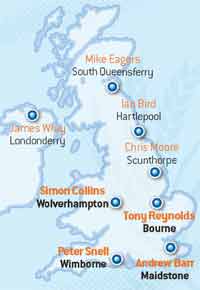Southern Barometer farms: More rain would be welcome

Crops on Farmers Weekly’s more southerly Barometer farms look surprisingly well as summer approaches
After the difficult autumn and relatively harsh winter, our representatives in Dorset, Kent, Lincolnshire and the West Midlands seem reasonably satisfied with crop prospects, though most would welcome more rain.
“Things have been pretty good,” said Peter Snell. His 70ha of home-saved Tipple spring barley sown at North Farm, Horton, at the end of February was moving on well.
Emma linseed had established well, drawing moisture from the clayey sand during April’s dry weather, he added. “But it could do with a drink now.”
Mr Snell said his decision not to apply a T0 spray to his winter wheat, all Alchemy, had proved correct, as the subsequent dry spell stifled disease development. Most fields looked well, with flag leaves just poking through by last weekend. He anticipated T2 treatment this week.

Peter Snell reckons at least two-thirds of his oilseed rape, of which he has several varieties, should deliver well
His T1 experience suggests that future chemicals may need to be ordered sooner. “We had planned to use Proline, as it’s good on stem-based disease. We ordered at the start of April, but it didn’t turn up in time. So we had to switch to Ennobe through our buying group Agritek.
“We’ve always taken it for granted that what we order will come. I might be tempted to stock up earlier next year.”
Most winter oilseed rape looked promising and recently received half-rate Proline (prothioconzole) against sclerotinia. He was sticking to a single treatment this season. “You have to stop spending some time,” he commented.
Least promising were two fields of second wheat hit by rabbits. “We’ve had more damage than normal. Myxy doesn’t seem to have affected the pests, but it’s wiped them out on a farm only three miles away.”
Rabbits leave OSR ragged
In Kent Andy Barr’s crops at East Lenham Farm, near Maidstone, have also been hit hard by rabbits, with winter oilseed crop suffering most.
“The rape’s a bit ragged round the edges, but, fortunately, I decided to plant 50% more than normal to try to buck the trend.”
Clearly, lower UK plantings wouldn’t affect world rape prices much. But with his spring barley already planned, and the prospect of others sowing much more of that crop and more spring beans, the extra area gamble to 150ha seemed worth taking, he said.
He also omitted a T0 treatment on his winter wheat, all sown by the end of September. “I um’d and ah’d, but in the end there just wasn’t the disease to justify it.”
 |
|---|
| Andy Barr: Winter oilseeds under attack from rabbits |
Despite that he waited until leaf three emerged before applying the T1 – just before strong winds began to disrupt progress. “We’ve been frustrated lately trying to get Terpal on to winter barley and fungicide on to spring barley.”
The latter, 45ha of Tipple sown in early March, looks “OK”, but all his cereals need more rain. “We’ve had just enough to keep us going, but it’s getting very dry,” he said at the end of last week.
Tempted by the cost saving Mr Barr decided to use granular urea for most of his nitrogen inputs this season. He’d never used solid urea before and was well aware of its reputation for losing N to the air. “So I did quite a bit of research before buying.”
This largely allayed any concerns. “We always put it on when rain was forecast and the vast majority went on when it was cool. The only real worry is when the weather gets hot.
“I’m a bit sceptical about the volatilisation story. If a lot of cheap ammonium nitrate was being imported no doubt we’d be hearing scare stories about how prone to leaching it is.”
No-till over-winter crop growth hard to swallow
For Tony Reynolds in Lincolnshire, learning to accept the contrast between crop appearance over winter and in spring is all part of becoming a no-till enthusiast.
“With our system, crops just sit there all winter doing nothing, and we have to suffer while our neighbours point out the supposed folly of our ways.” The picture at Thurlby Grange, Bourne, was especially worrying this season, he admitted.
“But come Valentine’s Day everything seems to kick in, crops burst out of the ground and don’t look back.
“Now all the wheat looks super – dark and dense – the oilseed rape’s in flower and growing like mad, particularly the Alienor, which we have for the first time. It seems to suit our system.”
Spring beans, 36ha of Fuego, also “hurtled” out of the ground, though weevils had needed controlling, he noted.
 |
|---|
| Tony Reynolds: All the wheat looks super |
A T0 wheat treatment is applied “more often than not” and was used again. “We thought we might avoid it this year, but in the end decided to play safe because of the crop density.”
Two unwelcome downsides have involved winter linseed and some of the 60ha of rape.
After 17ha on black fen soil seemed to be dying off, leaf analysis suggested the crop might be short of magnesium. “We treated it but it didn’t alter anything and we suspect it could have been something to do with the Galera we used on it to treat thistles.”
Mr Reynolds suspects the no-till system meant the chemical became more available to the crop by being absorbed by the straw of the previous crop. “It’s growing away OK now.”
His experience with the herbicide used on 12ha of WintaLin winter linseed grown for the first time was also troubling.
A 2m strip which missed the Crawler (carbetamide) treatment recommended by seed supplier, Premium Crops, was double the height and twice as thick as the sprayed crop, said Mr Reynolds.
Spring rape and barley encouraging
At Chillington Farm near Wolverhampton Ability spring oilseed rape and spring barley looked really well, reported Simon Collins.
Some 35ha of Tipple and Quench barley drilled in place of winter oilseed rape had been fertilised with the aim of achieving a malting sample. “But with spring barley plantings up and beer sales down, I dare say premiums will be hard to come by.”
 |
|---|
| Simon Collins: Spring OSR and barley doing well |
All feed and milling wheats came out of the “traditional” winter well, with Soissons drilled into hard frost between Christmas and the New Year especially thick and lush. Top dressing was due to finish this week with T2 fungicides scheduled for next week.
The main downside was winter oilseed rape, all Castille. “It’s disappointing – wet feet meant it was slow to get away and it got a hammering from pigeons. So I’m not expecting great things.”
Hybrid seed had been booked for next autumn in the hope of having a more robust, pigeon-resisting crop, he noted.
